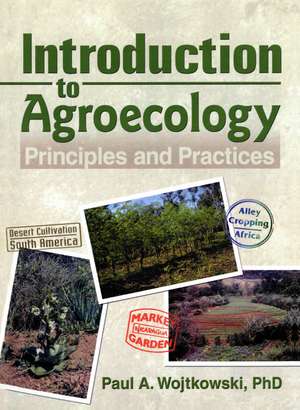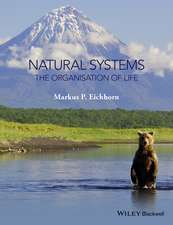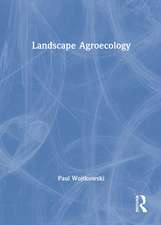Introduction to Agroecology: Principles and Practices
Autor Paul Wojtkowskien Limba Engleză Paperback – 17 oct 2006
The essence of agroecology lies in harnessing and harmonizing the forces of nature for productive purpose. Introduction to Agroecology: Principles and Practices comprehensively explains how this is done, providing a detailed, inclusive look at the underlying theories, concepts, and practices. This allows the reader to explore the full range of possibilities of the nature/agricultural interface and to view agroecology in its entirety, all while providing a clear understanding of the inherent complexity. Productive threats to cropping such as soil depletion, drought, plant-eating insects, heat and cold, weeds, and small and large animals are discussed in depth—with preventative strategies for each—all together in one easy-to-use book.
This unique introductory reference source is not only aimed at the novice, but also the more advanced student. In a departure from the norm for introductory material, extensive endnotes elaborate upon the basic information, presenting a full look at the arguments and controversies within the field. The endnotes include over 500 citations, offering a broad window that encompasses ecology, sociology, conservation and environmental studies, and several other fields. The text also contains numerous charts, figures, and tables to clarify data and ideas.
Introduction to Agroecology reviews and discusses:
- agroecological goals, such as profit, quality of life, and minimum disturbance of the natural ecosystem
- spatial principles, with resource concepts such as capture, production, balance, and biodiversity
- planting densities, ratios, and spatial patterns
- facilitation of nutrient and water capture-transfer
- ecosystem governance
- certainty-sustainability
- threats, such as drought, wind, flood, temperature, and fire
- the use of fences, repellant plants, fauna, and other means to stave off large animal threats
- basic insect countermeasures
- agrotechnologies
- subdivision, scaling, design packages, agrobiodiversity adjustments, and mimicry
- monocultures
- seasonal intercropping
- facilitative and productive agroforestry
- the use of reservoirs, corridors, wind structures, riparian buffers, firebreaks, and other means as auxiliary systems
- land modification
- social and community agroecology
- core approaches to alternative agriculture, including genetic, microbial, varietal, rotational, and others
- agroecosystem design
- many, many more topics
Preț: 683.91 lei
Preț vechi: 991.61 lei
-31% Nou
Puncte Express: 1026
Preț estimativ în valută:
130.88€ • 142.12$ • 109.94£
130.88€ • 142.12$ • 109.94£
Carte tipărită la comandă
Livrare economică 22 aprilie-06 mai
Preluare comenzi: 021 569.72.76
Specificații
ISBN-13: 9781560223177
ISBN-10: 1560223170
Pagini: 424
Dimensiuni: 152 x 229 x 26 mm
Greutate: 0.63 kg
Ediția:1
Editura: CRC Press
Colecția CRC Press
Locul publicării:Boca Raton, United States
ISBN-10: 1560223170
Pagini: 424
Dimensiuni: 152 x 229 x 26 mm
Greutate: 0.63 kg
Ediția:1
Editura: CRC Press
Colecția CRC Press
Locul publicării:Boca Raton, United States
Public țintă
Academic and PostgraduateCuprins
Preface,, Acknowledgments,, Chapter 1. Introduction,, Agroecology,, Agroecological Goals,, Mainstream Agriculture,, Agroecological Tools,, Alternative Agriculture,, Chapter 2. Spatial Principles,, Essential Resources,, Resource Concepts,, Biodiversity,, Measuring Growth and Yield,, Planting Density,, Planting Ratios,, Spatial Patterns,, Specific Interaction Zones,, Supplementary Additions,, Chapter 3. Agrobionomic Concepts,, Species Governance,, Ecosystem Governance,, Chapter 4. Productivity Threats,, Certainty-Sustainability,, General Countermeasures,, Threat Levels,, Specific Interaction Zones,, Climatic Threats,, Integrated Weed Management,, Larger Fauna,, Chapter 5. Insects and Plant Diseases,, Management,, Basic Insect Countermeasures,, Underlying Concepts,, Emphasis,, Chapter 6. Agroecological Concepts,, Agricultural Plants,, Agroecosystems,, Agrotechnologies,, Chapter 7. Monocultures,, Ecological Underpinnings,, Economic Underpinnings,, Monocultural Agrotechnologies,, Chapter 8. Seasonal Intercropping,, Pairings,, Ecological Underpinnings,, Economic Underpinnings,, Seasonal Agrotechnologies,, Chapter 9. Facilitative Agroforestry,, Pairings,, Ecological Underpinnings,, Economic Underpinnings,, Agrotechnologies,, Chapter 10. Productive Agroforestry,, Pairings,, Ec
Descriere
The essence of agroecology lies in harnessing and harmonizing the forces of nature for productive purpose. This book how it is done, providing a detailed, inclusive look at the underlying theories, concepts, and practices. This allows the reader to explore the full range of possibilities of the nature/agricultural interface and to view agroecology in its entirety, all while providing a clear understanding of the inherent complexity. Productive threats to cropping such as soil depletion, drought, plant-eating insects, heat and cold, weeds, and small and large animals are discussed in depth—with preventative strategies for each—all together in one easy-to-use book.











